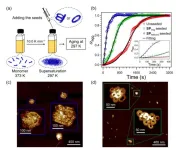(Press-News.org)
Supramolecular polymers are a new class of polymers that are currently being evaluated for material applications. These interesting compounds also play an important role in cellular activities in the body. "Supra," as the name suggests, is attributed to some unique properties that go beyond those of conventional polymers. Unlike traditional polymers, which are held together by strong, irreversible covalent bonds, supramolecular polymers are held together by weaker, reversible hydrogen bonds. They can reversibly assemble and disassemble, are highly versatile, and can be used for developing targeted drug delivery therapies, sensors to detect pollutants, diagnostic markers, energy storage devices, personal care products, and self-repairing and recyclable materials. Their excellent recyclability makes them wonderful candidate molecules for sustainable applications; however, there is one roadblock—researchers have yet to understand how to control their polymer growth.
There have, however, been advancements in this aspect. Researchers are now able to build "unlikely" polymers by triggering their assembly with "seeds," enabling control their polymer growth. There are two main mechanisms through which this seed-induced self-assembly occurs: primary nucleation or elongation, where the polymer grows from its end, and secondary nucleation, where new molecules join the polymer by sticking to its surface. The distinction between these processes is important because it enables researchers to better control and manipulate the growth of these unique polymers. Unfortunately, in most cases of seeded self-assembly, primary and secondary nucleation can be difficult to tell apart.
To tackle this issue, a group of researchers led by Professor Shiki Yagai from Chiba University aimed to compare and study the impact of these two processes while delineating the role of precisely controllable "seeded supramolecular polymerization." Their goal was to figure out how different seed shapes affect the formation of new supramolecular polymers; their findings were first published on May 10, 2023, and subsequently appeared in Volume 59, Issue 48 of Chemical Communications on June 18, 2023. Prof. Yagai tells us what motivated the team to pursue this topic of research: "Because of the difficulty in controlling polymerization, supramolecular polymers have not yet reached the point of practical application even though three decades have passed since their establishment as a concept." He is convinced, however, that because of their versatility, further research in this area is likely to lead to widespread applications of these self-organizing polymers in our daily lives.
For their experiments, the researchers used two supramolecular polymers as "seeds." While a closed-ended ring-shaped seed was used in a previous study, an open-ended, helicoidal seed was newly prepared. They found that when the open-ended, helicoidal seed was used, it acted as a template for the target molecules to attach and grow longer. On the other hand, when the closed-ended ring-shaped seed was used, it did not elongate itself, but rather served as a surface where new molecules could attach and form clusters, like a platform for new structures.
This research shows that the type of seed used in self-assembling supramolecular polymers influences the way the molecules assemble, and the final shape of the formed structures. This opens up exciting possibilities for various applications, from self-repairing and more easily recyclable materials to more advanced drug delivery systems, sensing technologies, and energy storage devices. As Prof. Yagai states, "By understanding these assembly processes, we can design and develop the next generation of more precise and environmentally friendly polymers with tailored structures and properties. The practical application of supramolecular polymers will enable us to produce plastic materials with lower energy consumption and reduce the energy required for recycling."
The ability to manipulate these versatile, self-assembling polymers at the molecular level offers great potential for addressing complex challenges and creating innovative, sustainable solutions in fields ranging from healthcare to environmental sustainability.
About Professor Shiki Yagai
Prof. Shiki Yagai is the Head of the Department of Applied Chemistry and Biotechnology, Graduate School of Engineering at the Institute for Advanced Academic Research (IAAR), Chiba University. His research focuses on the study and development of novel and unique molecular assemblies. He is particularly interested in supramolecular self-assembly systems, such as supramolecular polymers, stimuli-responsive molecular aggregates, smart soft materials, including liquid crystals and organogels, and solution-processable organic materials for optoelectronics. Prof. Yagai is an esteemed member of the Editorial Boards of journals like Responsive Materials, Journal of Photochemistry & Photobiology C: Photochemistry Reviews, and Scientific Reports.
END
WASHINGTON—People who have just one or two drinks per day are not protected against endocrine conditions such as obesity and type 2 diabetes, according to a new study published in the Endocrine Society’s Journal of Clinical Endocrinology & Metabolism.
Alcohol consumption is a significant public health concern because it is related to many medical conditions such as diabetes, obesity, liver conditions and heart disease. While it is widely accepted that excessive alcohol consumption causes a wide range of health issues, whether modest alcohol consumption has beneficial health effects remains controversial.
“Some research ...
Join us at NUTRITION 2023 for an exciting lineup of scientific symposia, educational sessions, hot-topic discussions, and award lectures covering the latest developments in nutrition science. NUTRITION 2023, the annual flagship meeting of the American Society for Nutrition (ASN), will be held July 22-25 at the Sheraton Boston.
Explore the meeting schedule and register for a press pass to attend.
The meeting will feature distinguished leaders in the field and important discussions that are helping to move nutrition science forward. Highlights include:
Ultra-processed foods – Observational studies ...
Scientists using the Atacama Large Millimeter/submillimeter Array (ALMA) to study the protoplanetary disk around a young star have discovered the most compelling chemical evidence to date of the formation of protoplanets. The discovery will provide astronomers with an alternate method for detecting and characterizing protoplanets when direct observations or imaging are not possible. The results will be published in an upcoming edition of The Astrophysical Journal Letters.
HD 169142 is a young star located in the constellation ...
FINDINGS
A new study shows that an artificial intelligence (AI) model co-developed by researchers in the UCLA Jonsson Comprehensive Cancer Center and department of Urology at UCLA can help doctors determine the extent of cancer within the prostate.
In a series of tests, the AI model was found to be more accurate at predicting tumor margins than magnetic resonance imaging (MRI), potentially improving the effectiveness of focal therapy, standardizing treatment margin definition, and reducing the chance of cancer recurrence.
BACKGROUND
Focal therapy, a minimally invasive treatment approach used for localized tumors, is an alternative ...
The 17 SDGs are the blueprint to achieve a better and more sustainable future for all. They address the global challenges we face, including climate change, environmental degradation, and inequality. The achievement of the SDGs depends on the ability to accurately measure progress towards meeting the associated targets based on timely, relevant, and reliable data. Citizen science offers an innovative approach to complement and enhance official statistics. Additionally, citizen science can help raise awareness, mobilize action, and therefore achieve transformative change.
The collection ...
LAS VEGAS – June 27, 2023 – Bariatric surgery, also called weight-loss or metabolic surgery, was associated with a 42% lower risk of major adverse cardiovascular events (MACE), including heart failure, heart attack, stroke, and atrial fibrillation in patients with moderate to severe obstructive sleep apnea (OSA), according to a new study from Cleveland Clinic and presented here today at the American Society for Metabolic and Bariatric Surgery (ASMBS) 2023 Annual Scientific Meeting. Researchers also report metabolic surgery ...
LAS VEGAS – June 27, 2023 – Patients with diabetes and a history of metabolic surgery had significantly fewer heart attacks, strokes, hospitalizations and death compared to matched patients who did not have the surgery, according to a new study* presented here today at the American Society for Metabolic and Bariatric Surgery (ASMBS) 2023 Annual Scientific Meeting.
Patients reduced their chances of winding up in a hospital with a heart attack by more than 35%, a stroke by more than 25% and congestive heart failure by nearly ...
LAS VEGAS – June, 27, 2023 – Patient eligibility for bariatric surgery, also called weight-loss or metabolic surgery, has expanded over the last decade and its safety and effectiveness even further established in clinical studies and professional guidelines, but relatively few patients with a body mass index (BMI) below 35 actually get the surgery in any given year, according to new studies presented here at the American Society for Metabolic and Bariatric Surgery (ASMBS) 2023 Annual Scientific Meeting.
In one study*, University of Southern California (USC) researchers found only 3.5% of the more than one million bariatric ...
LAS VEGAS – June 27, 2023 – More than half of patients with diabetes and a history of metabolic surgery (51%) experienced remission of their diabetes even if they did not achieve significant weight loss after surgery, according to a new study* presented here today at the American Society for Metabolic and Bariatric Surgery (ASMBS) 2023 Annual Scientific Meeting.
Researchers from Mayo Clinic in Rochester, University of California San Francisco in Fresno, and Stony Brook University Medical Center in New York performed a multicenter retrospective study of patients with diabetes who underwent gastric ...
Copenhagen, Denmark: More women are having just one embryo transferred per cycle of fertility treatment to get pregnant, according to research presented at the 39th annual meeting of the European Society of Human Reproduction and Embryology (ESHRE) [1].
Preliminary data from the ESHRE European IVF-monitoring Consortium (EIM) [2] shows that nearly three in five (57.6%) out of all in vitro fertilisation (IVF) and intracytoplasmic sperm injection (ICSI) procedures in 2020 in Europe involved the transfer ...

